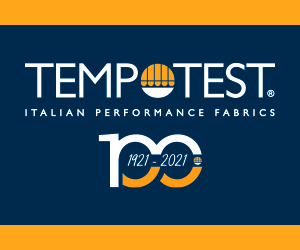Digital Printing Changes Bedding Industry Forever
August 13, 2002
New York — More bedding marketers are using digital printing systems to quickly turn out new printed products without the need for costly table strike-offs, according to Jesie Leskanic, principal of Fashion Technologies, based in Gaffney, S.C., with a service bureau in New York. And by using these systems, converters now have the ability to order finished items that could be manufactured anywhere in the world.
The company's Fashlink system encompasses the entire process of making a finished printed bedding ensemble from original artwork, including the production of a digital sample. "Instead of taking 12-14 weeks to produce a new item, this can be done with Fashlink in one to two weeks - and without tying up the printing machine," said Leskanic. The system matches the digital output of a sample with actual printing production runs from the original file, with no loss of reproduction in the process. Color scientist Dr. Patrick Chong, who joined Leskanic 11 years ago from Hong Kong, helped perfect the color system and technology used in Fashlink.
A fourth generation engraver, Leskanic started Fashion Technologies in 1959. However, bedding converters, who wanted to show more designs at lower cost with true reproduction, soon challenged him.
Table strike-offs - time-consuming samples - have always been a non-profit cost of producing bedding in a printing mill. "These can now be eliminated and the money saved by using digital output better employed to produce more designs," said Leskanic.
"This removes the need for a stylist to be based at the mill - and money wasted on engraving patterns that don't sell," he added. "Marketers can also wait until the last minute to produce new designs. And once the design is sold, we can do the engraving in a week, using the original data used to make the sample."
Some smaller converters rely on Fashion Technologies entirely, including the use of its CAD systems. Larger converters, however, usually prefer to use their own CAD equipment, with Fashion Technologies charged with producing the digital samples.
"We've invested seven years in developing this system," Leskanic pointed out. "We had to reproduce the wet printer's factory environment and mimic the output of the printing screens."
One of the major problems concerned capturing tonal qualities with "galvano" printing screens used to produce upper-end designs: the finished product never quite looked like the digital sample. "We can now get this right," Leskanic boasted, "so there's no difference between the sample and the eventual print run."
Fashion Technologies also plans to launch a direct engraving system for galvano-type screens. Based on lasers used in the aerospace industry, this process could be used by printers worldwide at a cost of around $375,000 per unit. "We don't want to be in the equipment business but we do hope to license our software for making the screens," Leskanic explained. "This will make obsolete existing lacquer screen-making machines, which produce flat colors with less subtlety. We also believe we can eliminate the technical limitations of galvano screens."
Leskanic said companies that continue to produce printed bedding in the traditional way will be at a disadvantage in future. "When worldwide tariffs disappear in 2005, you will have to work offshore in order to compete," he said. "And the only way to compete effectively is to adapt our system.
"Customers still have control of their designs. They can show digital samples to the retailer and produce the finished product somewhere else, whether it is in Pakistan, Israel, China or Korea."F&FI
The company's Fashlink system encompasses the entire process of making a finished printed bedding ensemble from original artwork, including the production of a digital sample. "Instead of taking 12-14 weeks to produce a new item, this can be done with Fashlink in one to two weeks - and without tying up the printing machine," said Leskanic. The system matches the digital output of a sample with actual printing production runs from the original file, with no loss of reproduction in the process. Color scientist Dr. Patrick Chong, who joined Leskanic 11 years ago from Hong Kong, helped perfect the color system and technology used in Fashlink.
A fourth generation engraver, Leskanic started Fashion Technologies in 1959. However, bedding converters, who wanted to show more designs at lower cost with true reproduction, soon challenged him.
Table strike-offs - time-consuming samples - have always been a non-profit cost of producing bedding in a printing mill. "These can now be eliminated and the money saved by using digital output better employed to produce more designs," said Leskanic.
"This removes the need for a stylist to be based at the mill - and money wasted on engraving patterns that don't sell," he added. "Marketers can also wait until the last minute to produce new designs. And once the design is sold, we can do the engraving in a week, using the original data used to make the sample."
Some smaller converters rely on Fashion Technologies entirely, including the use of its CAD systems. Larger converters, however, usually prefer to use their own CAD equipment, with Fashion Technologies charged with producing the digital samples.
"We've invested seven years in developing this system," Leskanic pointed out. "We had to reproduce the wet printer's factory environment and mimic the output of the printing screens."
One of the major problems concerned capturing tonal qualities with "galvano" printing screens used to produce upper-end designs: the finished product never quite looked like the digital sample. "We can now get this right," Leskanic boasted, "so there's no difference between the sample and the eventual print run."
Fashion Technologies also plans to launch a direct engraving system for galvano-type screens. Based on lasers used in the aerospace industry, this process could be used by printers worldwide at a cost of around $375,000 per unit. "We don't want to be in the equipment business but we do hope to license our software for making the screens," Leskanic explained. "This will make obsolete existing lacquer screen-making machines, which produce flat colors with less subtlety. We also believe we can eliminate the technical limitations of galvano screens."
Leskanic said companies that continue to produce printed bedding in the traditional way will be at a disadvantage in future. "When worldwide tariffs disappear in 2005, you will have to work offshore in order to compete," he said. "And the only way to compete effectively is to adapt our system.
"Customers still have control of their designs. They can show digital samples to the retailer and produce the finished product somewhere else, whether it is in Pakistan, Israel, China or Korea."F&FI
















